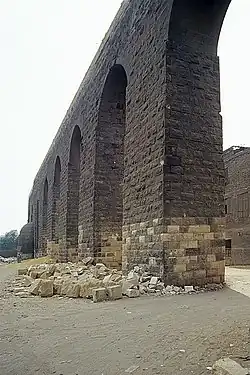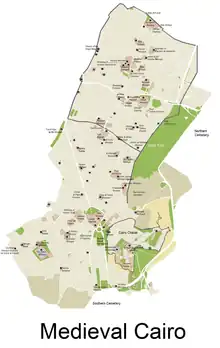Cairo Citadel Aqueduct
The Cairo Citadel Aqueduct or Mamluk Aqueduct (Arabic: سور مجرى العيون, romanized: sūr magra al-ʿayyūn)[1] is a medieval aqueduct system in Cairo, Egypt. It was first conceived and built during the Ayyubid period (under Salah ad-Din and his successors) but was later reworked by several Mamluk sultans to expand the provision of water to the Citadel of Cairo. Although no longer functioning today, much of the aqueduct structure, including its water intake tower, still stands.
| Cairo Citadel Aqueduct | |
|---|---|
| Native name Arabic: سور مجرى العيون | |
| Mamluk Aqueduct | |
 | |
| Type | aqueduct |
| Location | Cairo (near Old Cairo), Egypt |
| Coordinates | 30°01′19.5″N 31°13′49″E (Coordinates of Nile water intake tower) |
| Founder | al-Nasir Muhammad (and al-Ashraf Khalil) |
| Built | 1311-12 CE (approximate) |
| Restored | 1506-1508 |
| Restored by | Qansuh al-Ghuri |
| Architectural style(s) | Mamluk |
History

The Ayyubid aqueduct
The Citadel of Cairo was a massive fortified complex and royal residence begun by Salah ad-Din (Saladin) in 1176 CE and most likely finished by al-Kamil at the beginning of the 13th century.[2] The Citadel was the centerpiece of a new extensive defensive system for Cairo which included building a long wall around both Cairo and the older city of Fustat and connecting it to the Citadel. Salah ad-Din, or one of his Ayyubid successors, also developed the idea of bringing water from the Nile to the Citadel by building a canal along the top of this wall.[3] The aqueduct started from the wall's western end near Fustat (at the shore of the Nile), where water was raised through a series of waterwheels, and ran from there to the Citadel. This project was likely carried out or finished by al-Kamil (even though the full course of the defensive wall Salah ad-Din had envisioned was never fully finished).[2] This aqueduct system was built in addition to the famous Spiral Well built by Salah ad-Din (also known as the Bi'r Yusuf) inside the Citadel, which could provide water in times of siege in case the aqueduct was cut off.[2]
The first Mamluk aqueduct under al-Nasir Muhammad
During the Mamluk period, the Citadel was further developed by successive sultans into an even more elaborate complex, with more ambitious buildings. In particular, under Sultan al-Nasir Muhammad in the early 14th century the Citadel was expanded and several important palaces and monuments were built within and around it. In 1311 or 1312, al-Nasir Muhammad ordered the renovation and improvement of the Citadel's aqueduct.[3][4] His predecessor and brother, Sultan al-Ashraf Khalil, was likely responsible for having already built the water intake tower but was likely killed before he could do more.[2] Al-Nasir completed the project.
The intake tower was located on the shore of the Nile in the area now known as Fumm al-Khalig, north of Fustat (or "Old Cairo" today) and further north than the Ayyubid-era wall and canal.[3][2] The intake tower is hexagonal and featured four waterwheels (saaqiyyas) which raised water to the top of the tower, from where it flowed along a set of channels along the aqueduct. Along the way, al-Nasir built another tower with three more waterwheels raising the water to an even higher level, after which it continued to run along an aqueduct until it reached the foot of the citadel, at which point it was yet again raised by waterwheels in another tower.[2] From this last tower the water then entered into the Citadel and into a reservoir known as the Bi'r al-Sa'b Sawaqi ("Well of the Seven Waterwheels"), inside the Citadel's Southern Enclosure (near the harem area) and southwest of the famous Spiral Well of Salah ad-Din.[2] From this reservoir, water was distributed by an underground network to the rest of the buildings in the Citadel.[2] The aqueduct itself consisted of a channel carried along the top of large stone piers and arches, which ran for about one-and-a-half kilometers due east before turning northeast, and after half a kilometer the aqueduct then joins the old canal which was constructed along the top of Salah ad-Din's city wall.[4] This new system increased the amount of water brought to the Citadel, allowing al-Nasir Muhammad to carry out his major building projects in the Citadel, such as his mosque and the great palace known as the Qasr al-Ablaq ("Striped Palace").[3]
Later Mamluk restoration under al-Ghuri
In 1480, Sultan Qaytbay undertook major repairs on the aqueduct.[3] More significantly, from 1506 to 1508 Sultan al-Ghuri embarked on a major overhaul of the aqueduct system. He expanded or rebuilt the water intake tower, increasing the number of waterwheels from 4 to 6, and placed his emblem on the tower's walls.[3][2] The tall arched openings in the western sides of the tower, as seen today, are where the waterwheels were once located. At the top of the tower were other wheels which were turned by oxen to power the waterwheels below.[4] Al-Ghuri also rebuilt many of the aqueduct's arches, and the section of aqueduct closest to the Nile is attributed to him.[4]
The aqueduct after the Mamluk period
The aqueduct continued to be used during the Ottoman period, but fell into disuses during the French occupation of Egypt by Napoleon between 1798 and 1801 when the water intake tower was adapted for use by the French as a fort.[3] The aqueduct system definitively stopped providing water to the Citadel in the 19th century, probably as late as 1872 when the Khalij canal was filled-up during the construction of the new "modern" Cairo under Khedive Isma'il.[4]: 51 In the 20th century parts of the aqueduct were lost or destroyed due to disrepair and modern constructions; in particular, the final section of the aqueduct near the Citadel has disappeared.[2]
The aqueduct in the present day

Much of the aqueduct's course, except for the section near the Citadel, can still be seen today, as can the massive hexagonal water intake tower from al-Ghuri's renovations.[4] The monument has suffered from neglect and modern encroachments, but underwent some restoration and repairs in the 2000s.[3] As of 2018, there are also plans to redevelop and refurbish the area around the aqueduct so as to highlight it as a heritage monument.[5]
See also
References
- "Qanatir al-Mamluk". Archnet. Retrieved 2019-11-01.
- Rabat, Nasser O. (1995). The Citadel of Cairo: A New Interpretation of Royal Mamluk Architecture. E.J. Brill.
- Torky, Tarek (2019). "Aqueduct". Discover Islamic Art, Museum With No Frontiers. Retrieved November 1, 2019.
- Williams, Caroline (2019). Islamic Monuments in Cairo: The Practical Guide (7th ed.). The American University in Cairo Press.
- "Medieval Egypt aqueduct gets new lease of life". gulfnews.com. Retrieved 2019-11-01.

